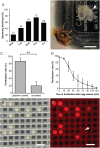Microinjection to deliver protein, mRNA, and DNA into zygotes of the cnidarian endosymbiosis model Aiptasia sp
- PMID: 30401930
- PMCID: PMC6219564
- DOI: 10.1038/s41598-018-34773-1
Microinjection to deliver protein, mRNA, and DNA into zygotes of the cnidarian endosymbiosis model Aiptasia sp
Abstract
Reef-building corals depend on an intracellular symbiosis with photosynthetic dinoflagellates for their survival in nutrient-poor oceans. Symbionts are phagocytosed by coral larvae from the environment and transfer essential nutrients to their hosts. Aiptasia, a small tropical marine sea anemone, is emerging as a tractable model system for coral symbiosis; however, to date functional tools and genetic transformation are lacking. Here we have established an efficient workflow to collect Aiptasia eggs for in vitro fertilization and microinjection as the basis for experimental manipulations in the developing embryo and larvae. We demonstrate that protein, mRNA, and DNA can successfully be injected into live Aiptasia zygotes to label actin with recombinant Lifeact-eGFP protein; to label nuclei and cell membranes with NLS-eGFP and farnesylated mCherry translated from injected mRNA; and to transiently drive transgene expression from an Aiptasia-specific promoter, respectively, in embryos and larvae. These proof-of-concept approaches pave the way for future functional studies of development and symbiosis establishment in Aiptasia, a powerful model to unravel the molecular mechanisms underlying intracellular coral-algal symbiosis.
Conflict of interest statement
The authors declare no competing interests.
Figures




References
-
- Muscatine, L. The role of symbiotic algae in carbon and energy flux in coral reefs. In Coral Reefs (ed. Zubinsky, Z.) 75–87 (Elsevier, 1990).
-
- van Oppen M. In vitro establishment of symbiosis in Acropora millepora planulae. Coral Reefs. 2001;20:200. doi: 10.1007/s003380100167. - DOI
-
- Rodriguez-Lanetty M, Wood-Charlson E, Hollingsworth L, Krupp D, Weis V. Temporal and spatial infection dynamics indicate recognition events in the early hours of a dinoflagellate/coral symbiosis. Mar. Biol. 2006;149:713–719. doi: 10.1007/s00227-006-0272-x. - DOI
Publication types
MeSH terms
Substances
LinkOut - more resources
Full Text Sources

